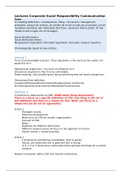Samenvatting
Summary Corporate Social Responsibility (lecture notes and corresponding literature)
- Instelling
- Tilburg University (UVT)
This document contains all information necessary for the final exam. Lecture notes of Corporate Social Responsibility and the corresponding articles in the right sequence. Some example exam questions are added to the document.
[Meer zien]




